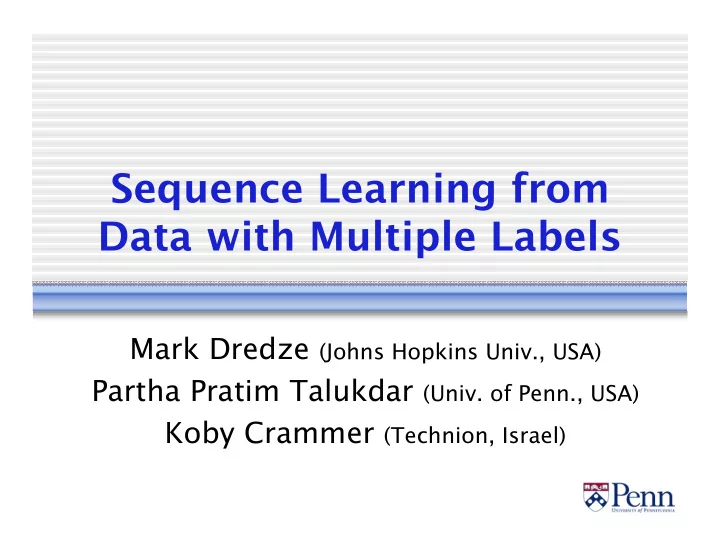

Sequence Learning from Data with Multiple Labels Mark Dredze (Johns Hopkins Univ., USA) Partha Pratim Talukdar (Univ. of Penn., USA) Koby Crammer (Technion, Israel)
Motivation • Labeled data is expensive • Multiple cheap but noisy annotations may be available (e.g. Amazon Mechanical Turk) The problem: Adjudication ! • Can we learn from multiple labels without adjudication?
Learning Setting • Input: Feature sequence (sentence) Set of initial priors over labels at each position John Blitzer studies at the University of Pennsylvania . PER/0.7 PER/0.7 O/1.0 O/1.0 O/1.0 ORG/1.0 ORG/1.0 ORG/0.3 O/1.0 O/0.1 O/0.1 LOC/0.7 ORG/0.1 LOC/0.1 LOC/0.1 • Output: Trained sequence labeler (e.g. CRF) Take label priors into account during training
Why Multiple Labels? • Easy to encode guesses as to correct label Users provide labels Allows multiple conflicting labels Don’t need to resolve conflicts (saves time)
Comparison with Canonical Multi-Label Learning Canonical Multi-Label This Paper 1. Multiple labels per 1. Same, but only one of instance during the labels is correct training 2. Only one valid label 2. Each instance can have per instance multiple valid labels
Previous Work • Jin and Ghahramani, NIPS 2003 Classification setting (simple output) • This paper Structured Prediction (complex output)
Generality of the Learning Setting • Multi-Label setting encodes standard learning settings Unsupervised uniform prior over labels Supervised per-position prior of 1.0 Semi-supervised combination of above
Learning with Multiple Labels • Two learning goals Find a model that best describes the data Respect per-position input prior over labels, as much as possible • Balance these two goals in a single objective function
Multi-CRF CRF Multi-CRF Objective CRF Estimated Prior Initial Prior
Multi-EM Algorithm • M-step Learn a Multi-CRF that models all given labels at each position Weigh possible labels by estimated label priors • E-step Re-estimate label priors based on model and initial prior Balances between CRF’s label estimates and the input priors
Experimental Setup • Dataset CoNLL-2003: Named Entity Dataset with PER, LOC and ORG tags, 3454 test instances • Each instance has two different sequences Gold labels Labels generated by an HMM • Noise level: probability of incorrect sequence getting higher prior (higher is noisier)
Variants • MAX Standard CRF with max prior at each position. • MAX-EM EM with MAX in M step • Multi Multi-CRF • Multi-EM EM with Multi-CRF in M step
Results on CoNLL Data Gold Noise Decreases Multi-EM most effective on noisier data, especially when less supervision is available.
When is Learning Successful? • Effective over single-label learning with Small amount training data (low quantity) Lots of noise (low quality) • Additional label may add information in this setting.
Conclusion • Presented novel models for learning structured predictors from multi- labeled data, in presence of noise. • Experimental results on real world data • Analyzed when learning in such setting is effective.
Thanks!
Recommend
More recommend